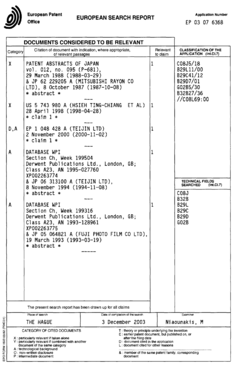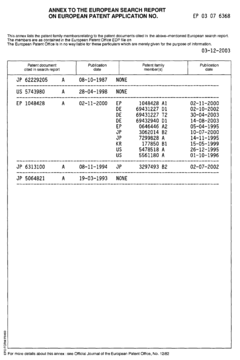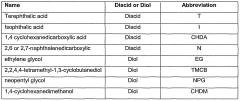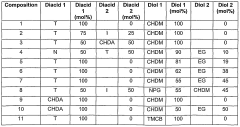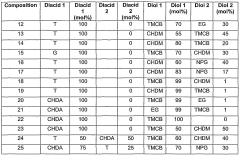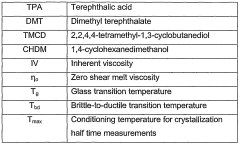Polycarbonate for Advanced Display Technologies
JUL 1, 20259 MIN READ
Generate Your Research Report Instantly with AI Agent
Patsnap Eureka helps you evaluate technical feasibility & market potential.
Polycarbonate Display Tech Evolution
Polycarbonate has undergone significant evolution in display technologies over the past few decades. Initially used primarily for its impact resistance and optical clarity in applications such as safety glasses and automotive headlamps, polycarbonate has since found its way into advanced display technologies due to its unique combination of properties.
The journey of polycarbonate in display technologies began in the late 1990s with the advent of LCD screens. Its high transparency and low birefringence made it an ideal material for light guide plates in backlit displays. As flat-panel displays became more prevalent, polycarbonate's role expanded to include protective covers and bezels, leveraging its durability and design flexibility.
The mid-2000s saw a surge in mobile devices, driving demand for lighter, thinner, and more robust displays. Polycarbonate's low density and high impact strength positioned it as a key material in this evolution. Manufacturers began developing specialized grades of polycarbonate with enhanced optical properties, reduced haze, and improved scratch resistance to meet the demanding requirements of touchscreen devices.
As display technologies advanced further, so did the applications of polycarbonate. The emergence of flexible and foldable displays in the 2010s presented new challenges and opportunities. Polycarbonate manufacturers responded by developing ultra-thin, flexible grades that could withstand repeated bending without compromising optical clarity or mechanical integrity.
Recent years have seen a focus on sustainability and circular economy principles in the display industry. This has led to innovations in recycled and bio-based polycarbonates, addressing environmental concerns while maintaining the high performance required for advanced display applications.
The evolution of polycarbonate in display technologies has also been marked by continuous improvements in processing techniques. Advances in injection molding, film extrusion, and surface treatment technologies have enabled the production of increasingly complex and precise polycarbonate components for displays.
Looking ahead, the role of polycarbonate in display technologies is set to expand further. Emerging trends such as augmented reality (AR) and virtual reality (VR) displays present new opportunities for polycarbonate materials. The development of polycarbonate-based optical waveguides and high-refractive-index formulations are areas of active research, promising to enhance the performance and user experience of next-generation display devices.
The journey of polycarbonate in display technologies began in the late 1990s with the advent of LCD screens. Its high transparency and low birefringence made it an ideal material for light guide plates in backlit displays. As flat-panel displays became more prevalent, polycarbonate's role expanded to include protective covers and bezels, leveraging its durability and design flexibility.
The mid-2000s saw a surge in mobile devices, driving demand for lighter, thinner, and more robust displays. Polycarbonate's low density and high impact strength positioned it as a key material in this evolution. Manufacturers began developing specialized grades of polycarbonate with enhanced optical properties, reduced haze, and improved scratch resistance to meet the demanding requirements of touchscreen devices.
As display technologies advanced further, so did the applications of polycarbonate. The emergence of flexible and foldable displays in the 2010s presented new challenges and opportunities. Polycarbonate manufacturers responded by developing ultra-thin, flexible grades that could withstand repeated bending without compromising optical clarity or mechanical integrity.
Recent years have seen a focus on sustainability and circular economy principles in the display industry. This has led to innovations in recycled and bio-based polycarbonates, addressing environmental concerns while maintaining the high performance required for advanced display applications.
The evolution of polycarbonate in display technologies has also been marked by continuous improvements in processing techniques. Advances in injection molding, film extrusion, and surface treatment technologies have enabled the production of increasingly complex and precise polycarbonate components for displays.
Looking ahead, the role of polycarbonate in display technologies is set to expand further. Emerging trends such as augmented reality (AR) and virtual reality (VR) displays present new opportunities for polycarbonate materials. The development of polycarbonate-based optical waveguides and high-refractive-index formulations are areas of active research, promising to enhance the performance and user experience of next-generation display devices.
Market Demand Analysis
The market demand for polycarbonate in advanced display technologies has been experiencing significant growth in recent years. This surge is primarily driven by the increasing adoption of high-performance displays across various industries, including consumer electronics, automotive, and healthcare. The global polycarbonate market for display applications is expected to expand at a robust rate, with a particular focus on lightweight, durable, and optically superior materials.
In the consumer electronics sector, the demand for polycarbonate in display technologies is largely fueled by the growing popularity of smartphones, tablets, and wearable devices. These devices require materials that can withstand daily wear and tear while maintaining optical clarity and impact resistance. Polycarbonate's unique combination of properties makes it an ideal choice for protective covers and display components in these devices.
The automotive industry is another key driver of market demand for polycarbonate in advanced display technologies. With the increasing integration of digital displays in vehicles, from infotainment systems to heads-up displays, there is a growing need for materials that can withstand harsh environmental conditions while providing excellent optical performance. Polycarbonate's ability to resist UV radiation, temperature fluctuations, and impact makes it a preferred material for automotive display applications.
In the healthcare sector, the demand for polycarbonate in display technologies is driven by the need for durable and easily sterilizable materials in medical devices and equipment. From patient monitors to diagnostic imaging displays, polycarbonate's chemical resistance and optical clarity make it an excellent choice for these critical applications.
The market for polycarbonate in advanced display technologies is also influenced by emerging trends in flexible and foldable displays. As manufacturers explore new form factors and designs, there is an increasing demand for materials that can provide both flexibility and durability. Polycarbonate's ability to be molded into complex shapes while maintaining its optical and mechanical properties positions it as a promising material for these innovative display technologies.
Geographically, the Asia-Pacific region is expected to dominate the market demand for polycarbonate in advanced display technologies. This is primarily due to the concentration of consumer electronics manufacturing in countries like China, South Korea, and Japan. However, North America and Europe are also significant markets, driven by the automotive and healthcare sectors.
As the display technology landscape continues to evolve, the demand for high-performance polycarbonate is expected to grow. Manufacturers are increasingly focusing on developing specialized grades of polycarbonate that offer enhanced optical properties, improved durability, and better processability to meet the specific requirements of advanced display applications. This ongoing innovation in material science is likely to further drive market growth and expand the potential applications of polycarbonate in the display technology sector.
In the consumer electronics sector, the demand for polycarbonate in display technologies is largely fueled by the growing popularity of smartphones, tablets, and wearable devices. These devices require materials that can withstand daily wear and tear while maintaining optical clarity and impact resistance. Polycarbonate's unique combination of properties makes it an ideal choice for protective covers and display components in these devices.
The automotive industry is another key driver of market demand for polycarbonate in advanced display technologies. With the increasing integration of digital displays in vehicles, from infotainment systems to heads-up displays, there is a growing need for materials that can withstand harsh environmental conditions while providing excellent optical performance. Polycarbonate's ability to resist UV radiation, temperature fluctuations, and impact makes it a preferred material for automotive display applications.
In the healthcare sector, the demand for polycarbonate in display technologies is driven by the need for durable and easily sterilizable materials in medical devices and equipment. From patient monitors to diagnostic imaging displays, polycarbonate's chemical resistance and optical clarity make it an excellent choice for these critical applications.
The market for polycarbonate in advanced display technologies is also influenced by emerging trends in flexible and foldable displays. As manufacturers explore new form factors and designs, there is an increasing demand for materials that can provide both flexibility and durability. Polycarbonate's ability to be molded into complex shapes while maintaining its optical and mechanical properties positions it as a promising material for these innovative display technologies.
Geographically, the Asia-Pacific region is expected to dominate the market demand for polycarbonate in advanced display technologies. This is primarily due to the concentration of consumer electronics manufacturing in countries like China, South Korea, and Japan. However, North America and Europe are also significant markets, driven by the automotive and healthcare sectors.
As the display technology landscape continues to evolve, the demand for high-performance polycarbonate is expected to grow. Manufacturers are increasingly focusing on developing specialized grades of polycarbonate that offer enhanced optical properties, improved durability, and better processability to meet the specific requirements of advanced display applications. This ongoing innovation in material science is likely to further drive market growth and expand the potential applications of polycarbonate in the display technology sector.
Current Challenges
Polycarbonate (PC) has emerged as a promising material for advanced display technologies, yet it faces several significant challenges that hinder its widespread adoption and optimal performance. One of the primary obstacles is the material's inherent yellowing tendency when exposed to prolonged UV radiation. This discoloration not only affects the aesthetic appeal of displays but also compromises the optical clarity and color accuracy crucial for high-quality visual output.
Another critical challenge lies in the thermal stability of polycarbonate. As display technologies evolve to incorporate higher brightness levels and more compact designs, the heat generated within these devices increases substantially. Polycarbonate's relatively low glass transition temperature and thermal conductivity can lead to warping, distortion, or even structural failure under prolonged exposure to elevated temperatures, potentially compromising the integrity and longevity of display components.
The mechanical properties of polycarbonate present a dual-edged sword for display applications. While its impact resistance is superior to many alternative materials, making it ideal for portable devices, its scratch resistance is comparatively poor. This susceptibility to surface damage can significantly impact the visual quality and durability of displays, necessitating additional protective coatings or treatments that may affect optical performance or increase production costs.
Chemical resistance poses another significant hurdle for polycarbonate in display technologies. The material is vulnerable to certain solvents and chemicals commonly used in manufacturing processes or encountered during device use. This sensitivity can lead to crazing, cracking, or degradation of the polycarbonate components, potentially compromising the structural integrity and optical properties of the display.
Optical performance remains a critical area of focus for improvement in polycarbonate-based displays. While the material offers good transparency, achieving the ultra-high clarity and minimal birefringence required for advanced display technologies, particularly in applications like augmented reality (AR) and virtual reality (VR), remains challenging. Enhancing these optical properties without compromising other beneficial characteristics of polycarbonate is a complex balancing act.
Lastly, the environmental impact and recyclability of polycarbonate present ongoing challenges. As sustainability becomes an increasingly important consideration in technology development, finding ways to effectively recycle polycarbonate components from displays and reduce the material's environmental footprint throughout its lifecycle is crucial. This includes addressing issues related to additives and coatings that may complicate recycling processes.
Addressing these multifaceted challenges requires interdisciplinary research efforts, combining materials science, optical engineering, and sustainable manufacturing practices. Innovations in polymer chemistry, surface treatments, and composite materials hold promise for overcoming these limitations, potentially unlocking the full potential of polycarbonate in next-generation display technologies.
Another critical challenge lies in the thermal stability of polycarbonate. As display technologies evolve to incorporate higher brightness levels and more compact designs, the heat generated within these devices increases substantially. Polycarbonate's relatively low glass transition temperature and thermal conductivity can lead to warping, distortion, or even structural failure under prolonged exposure to elevated temperatures, potentially compromising the integrity and longevity of display components.
The mechanical properties of polycarbonate present a dual-edged sword for display applications. While its impact resistance is superior to many alternative materials, making it ideal for portable devices, its scratch resistance is comparatively poor. This susceptibility to surface damage can significantly impact the visual quality and durability of displays, necessitating additional protective coatings or treatments that may affect optical performance or increase production costs.
Chemical resistance poses another significant hurdle for polycarbonate in display technologies. The material is vulnerable to certain solvents and chemicals commonly used in manufacturing processes or encountered during device use. This sensitivity can lead to crazing, cracking, or degradation of the polycarbonate components, potentially compromising the structural integrity and optical properties of the display.
Optical performance remains a critical area of focus for improvement in polycarbonate-based displays. While the material offers good transparency, achieving the ultra-high clarity and minimal birefringence required for advanced display technologies, particularly in applications like augmented reality (AR) and virtual reality (VR), remains challenging. Enhancing these optical properties without compromising other beneficial characteristics of polycarbonate is a complex balancing act.
Lastly, the environmental impact and recyclability of polycarbonate present ongoing challenges. As sustainability becomes an increasingly important consideration in technology development, finding ways to effectively recycle polycarbonate components from displays and reduce the material's environmental footprint throughout its lifecycle is crucial. This includes addressing issues related to additives and coatings that may complicate recycling processes.
Addressing these multifaceted challenges requires interdisciplinary research efforts, combining materials science, optical engineering, and sustainable manufacturing practices. Innovations in polymer chemistry, surface treatments, and composite materials hold promise for overcoming these limitations, potentially unlocking the full potential of polycarbonate in next-generation display technologies.
Existing PC Solutions
01 Synthesis and modification of polycarbonates
Various methods for synthesizing and modifying polycarbonates are explored, including novel catalysts, reaction conditions, and additives to improve properties such as molecular weight, thermal stability, and optical clarity. These techniques aim to enhance the overall performance and versatility of polycarbonate materials for different applications.- Polycarbonate synthesis and modification: Various methods for synthesizing and modifying polycarbonates are explored, including new catalysts, reaction conditions, and additives to improve properties such as molecular weight, thermal stability, and optical clarity. These techniques aim to enhance the overall performance and versatility of polycarbonate materials.
- Polycarbonate blends and composites: Development of polycarbonate blends and composites with other polymers or materials to achieve improved mechanical, thermal, or electrical properties. These formulations often target specific applications such as electronics, automotive parts, or consumer goods, offering enhanced performance characteristics compared to pure polycarbonate.
- Polycarbonate processing techniques: Advancements in processing techniques for polycarbonate materials, including extrusion, injection molding, and film formation. These methods focus on improving production efficiency, reducing defects, and enhancing the final product quality, such as surface finish or dimensional stability.
- Polycarbonate applications in electronics: Specialized polycarbonate formulations and designs for electronic applications, including housings, components, and protective layers. These developments focus on properties such as flame retardancy, EMI shielding, and heat dissipation, crucial for modern electronic devices and equipment.
- Recycling and sustainability of polycarbonates: Innovations in recycling processes and sustainable production methods for polycarbonates, addressing environmental concerns and circular economy principles. This includes chemical recycling techniques, bio-based alternatives, and strategies to reduce the environmental impact of polycarbonate production and disposal.
02 Polycarbonate blends and composites
Development of polycarbonate blends and composites with other polymers or materials to achieve improved mechanical, thermal, and chemical properties. These formulations often target specific applications such as electronics, automotive parts, or consumer goods, offering enhanced performance characteristics compared to pure polycarbonate.Expand Specific Solutions03 Flame retardant polycarbonate formulations
Creation of flame retardant polycarbonate formulations through the incorporation of various additives or chemical modifications. These developments aim to improve the fire resistance of polycarbonate materials while maintaining other desirable properties, making them suitable for applications with stringent safety requirements.Expand Specific Solutions04 Optical and electronic applications of polycarbonates
Utilization of polycarbonates in optical and electronic applications, including the development of specialized grades with high transparency, low birefringence, and improved impact resistance. These materials find use in lenses, displays, data storage devices, and other high-performance optical components.Expand Specific Solutions05 Recycling and sustainability of polycarbonates
Advancements in recycling technologies and sustainable production methods for polycarbonates, including chemical recycling processes, bio-based alternatives, and strategies to reduce environmental impact. These efforts aim to improve the lifecycle sustainability of polycarbonate materials and address growing environmental concerns.Expand Specific Solutions
Key Industry Players
The research on polycarbonate for advanced display technologies is in a mature stage, with a competitive landscape dominated by established chemical and materials companies. The market size is substantial, driven by growing demand for high-performance display materials in consumer electronics, automotive, and other industries. Key players like Covestro, Mitsubishi Gas Chemical, SABIC, and LG Chem have significant market presence and technological capabilities. These companies are investing in R&D to develop innovative polycarbonate formulations with enhanced optical, mechanical, and thermal properties for next-generation displays. The technology's maturity is evident in the diverse applications and ongoing improvements, with companies focusing on sustainability and cost-effectiveness to maintain their competitive edge.
Covestro Deutschland AG
Technical Solution: Covestro has developed high-performance polycarbonate resins specifically tailored for advanced display technologies. Their Makrolon® series offers exceptional optical clarity, high impact resistance, and thermal stability. For OLED displays, they've engineered ultra-thin polycarbonate films with thickness down to 20-60 μm, providing flexibility and durability for foldable devices[1]. Covestro's polycarbonates also feature high light transmission (up to 90%) and low birefringence, crucial for AR/VR applications[2]. They've incorporated UV stabilizers and anti-glare additives to enhance outdoor readability and longevity of displays. Recent innovations include polycarbonate blends with reduced water absorption, improving dimensional stability in high-humidity environments[3].
Strengths: Exceptional optical clarity, high impact resistance, and thermal stability. Versatility in applications from rigid to flexible displays. Weaknesses: Higher cost compared to some alternative materials, potential for yellowing over extended periods of UV exposure.
Mitsubishi Gas Chemical Co., Inc.
Technical Solution: Mitsubishi Gas Chemical has pioneered the development of specialty polycarbonates for advanced display technologies. Their Iupilon® series offers high transparency and low birefringence, crucial for large-format LCD and OLED displays. They've developed flame-retardant grades that meet UL94 V-0 standards without compromising optical properties[4]. MGC's polycarbonates feature improved resistance to chemicals and stress cracking, enhancing durability in touch-screen applications. Their recent focus has been on developing ultra-low moisture absorption grades, reducing the risk of warpage in thin display components. MGC has also introduced polycarbonate films with controlled surface roughness for light diffusion in edge-lit displays, improving brightness uniformity[5].
Strengths: High transparency, low birefringence, and excellent flame-retardant properties. Specialized grades for specific display applications. Weaknesses: Limited global production capacity compared to larger competitors, potentially affecting supply chain flexibility.
Core PC Innovations
Polycarbonate films prepared by coating methods
PatentInactiveEP1369451A3
Innovation
- A method involving the application of a low viscosity polycarbonate resin fluid onto a moving carrier substrate, where the film is dried and then peeled, minimizing shear forces and allowing for the production of films with low in-plane birefringence and high uniformity, enabling the creation of films from 1 to 500 microns thickness without the need for co-solvents or lubricants, and facilitating multi-layer applications.
Polyester-polycarbonate blends for diffuser sheets with improved luminance
PatentWO2006127755A2
Innovation
- Development of miscible blends of polycarbonates and polyesters with specific compositions, including terephthalic acid, 1,4-cyclohexanedimethanol, and 2,2,4,4-tetramethyl-1,3-cyclobutanediol, along with particulate light diffusing components and brightness enhancing agents, to create diffuser materials with improved luminance and brightness.
Environmental Impact
The environmental impact of polycarbonate in advanced display technologies is a critical consideration as the industry moves towards more sustainable practices. Polycarbonate, while offering excellent optical and mechanical properties, presents several environmental challenges throughout its lifecycle.
Production of polycarbonate involves energy-intensive processes and the use of potentially harmful chemicals, including bisphenol A (BPA). The manufacturing process contributes to greenhouse gas emissions and can lead to the release of volatile organic compounds (VOCs) into the atmosphere. Additionally, the production of polycarbonate relies heavily on fossil fuel-derived raw materials, raising concerns about resource depletion and carbon footprint.
During the use phase, polycarbonate displays generally have a long lifespan, which can be seen as a positive environmental attribute. However, the durability of polycarbonate can become problematic at the end of a product's life cycle. The material's resistance to degradation means that it persists in the environment for extended periods when not properly disposed of or recycled.
Recycling polycarbonate presents both opportunities and challenges. While technically recyclable, the process is complex and often not economically viable on a large scale. The presence of additives and coatings in display applications can further complicate recycling efforts. As a result, a significant portion of polycarbonate waste ends up in landfills or incinerators, contributing to environmental pollution.
The potential leaching of BPA from polycarbonate products has raised concerns about its impact on ecosystems and human health. Although the use of BPA in certain applications has been restricted in some regions, its presence in polycarbonate displays remains a topic of ongoing research and debate.
In response to these environmental concerns, the display industry is exploring alternatives to traditional polycarbonate. Bio-based polycarbonates derived from renewable resources are being developed to reduce reliance on fossil fuels. Additionally, research into more easily recyclable polycarbonate formulations and improved recycling technologies is ongoing.
The industry is also focusing on designing products for easier disassembly and material recovery at the end of their lifecycle. This approach, known as Design for Environment (DfE), aims to minimize the environmental impact of polycarbonate displays by facilitating more efficient recycling and reducing waste.
As environmental regulations become more stringent, manufacturers are increasingly required to consider the full lifecycle impact of their products. This has led to greater investment in lifecycle assessment (LCA) studies for polycarbonate displays, helping to identify areas for improvement and guiding the development of more sustainable alternatives.
Production of polycarbonate involves energy-intensive processes and the use of potentially harmful chemicals, including bisphenol A (BPA). The manufacturing process contributes to greenhouse gas emissions and can lead to the release of volatile organic compounds (VOCs) into the atmosphere. Additionally, the production of polycarbonate relies heavily on fossil fuel-derived raw materials, raising concerns about resource depletion and carbon footprint.
During the use phase, polycarbonate displays generally have a long lifespan, which can be seen as a positive environmental attribute. However, the durability of polycarbonate can become problematic at the end of a product's life cycle. The material's resistance to degradation means that it persists in the environment for extended periods when not properly disposed of or recycled.
Recycling polycarbonate presents both opportunities and challenges. While technically recyclable, the process is complex and often not economically viable on a large scale. The presence of additives and coatings in display applications can further complicate recycling efforts. As a result, a significant portion of polycarbonate waste ends up in landfills or incinerators, contributing to environmental pollution.
The potential leaching of BPA from polycarbonate products has raised concerns about its impact on ecosystems and human health. Although the use of BPA in certain applications has been restricted in some regions, its presence in polycarbonate displays remains a topic of ongoing research and debate.
In response to these environmental concerns, the display industry is exploring alternatives to traditional polycarbonate. Bio-based polycarbonates derived from renewable resources are being developed to reduce reliance on fossil fuels. Additionally, research into more easily recyclable polycarbonate formulations and improved recycling technologies is ongoing.
The industry is also focusing on designing products for easier disassembly and material recovery at the end of their lifecycle. This approach, known as Design for Environment (DfE), aims to minimize the environmental impact of polycarbonate displays by facilitating more efficient recycling and reducing waste.
As environmental regulations become more stringent, manufacturers are increasingly required to consider the full lifecycle impact of their products. This has led to greater investment in lifecycle assessment (LCA) studies for polycarbonate displays, helping to identify areas for improvement and guiding the development of more sustainable alternatives.
Optical Performance Metrics
Optical performance metrics are crucial in evaluating the suitability of polycarbonate for advanced display technologies. These metrics provide quantitative measures of how well the material can transmit, manipulate, and enhance light for optimal display performance.
One of the primary optical performance metrics for polycarbonate in display applications is light transmittance. This measure indicates the percentage of incident light that passes through the material. For advanced displays, high transmittance is essential to ensure brightness and energy efficiency. Polycarbonate typically offers excellent light transmittance, often exceeding 85% in the visible spectrum.
Refractive index is another critical metric, determining how light bends when passing through the material. This property is particularly important for lens design in augmented reality (AR) and virtual reality (VR) displays. Polycarbonate's refractive index, usually around 1.58-1.59, provides a good balance between light bending capability and material thickness.
Haze is a measure of the light scattering within the material, affecting image clarity and contrast. Low haze values are desirable for display applications, and high-quality polycarbonate can achieve haze levels below 1%, ensuring crisp and clear images.
Birefringence, the optical property of double refraction, is particularly relevant for polarized displays. Low birefringence is crucial to maintain image quality and prevent color distortion. Advanced polycarbonate formulations have been developed to minimize birefringence, making them suitable for LCD and OLED displays.
Color shift and yellowing index are important metrics for long-term performance. These measure the material's resistance to color changes over time, especially when exposed to UV light or high temperatures. Enhanced polycarbonate grades offer improved stability in these areas, maintaining optical clarity and color neutrality over extended periods.
Optical anisotropy, which can cause variations in refractive index depending on the direction of light propagation, is another consideration. Minimizing optical anisotropy is essential for uniform display performance, particularly in large-format displays or those with wide viewing angles.
Surface quality metrics, such as roughness and waviness, also play a role in optical performance. These factors affect light scattering and reflection at the material's surface. Advanced polishing techniques and coatings can significantly improve these surface properties in polycarbonate components.
One of the primary optical performance metrics for polycarbonate in display applications is light transmittance. This measure indicates the percentage of incident light that passes through the material. For advanced displays, high transmittance is essential to ensure brightness and energy efficiency. Polycarbonate typically offers excellent light transmittance, often exceeding 85% in the visible spectrum.
Refractive index is another critical metric, determining how light bends when passing through the material. This property is particularly important for lens design in augmented reality (AR) and virtual reality (VR) displays. Polycarbonate's refractive index, usually around 1.58-1.59, provides a good balance between light bending capability and material thickness.
Haze is a measure of the light scattering within the material, affecting image clarity and contrast. Low haze values are desirable for display applications, and high-quality polycarbonate can achieve haze levels below 1%, ensuring crisp and clear images.
Birefringence, the optical property of double refraction, is particularly relevant for polarized displays. Low birefringence is crucial to maintain image quality and prevent color distortion. Advanced polycarbonate formulations have been developed to minimize birefringence, making them suitable for LCD and OLED displays.
Color shift and yellowing index are important metrics for long-term performance. These measure the material's resistance to color changes over time, especially when exposed to UV light or high temperatures. Enhanced polycarbonate grades offer improved stability in these areas, maintaining optical clarity and color neutrality over extended periods.
Optical anisotropy, which can cause variations in refractive index depending on the direction of light propagation, is another consideration. Minimizing optical anisotropy is essential for uniform display performance, particularly in large-format displays or those with wide viewing angles.
Surface quality metrics, such as roughness and waviness, also play a role in optical performance. These factors affect light scattering and reflection at the material's surface. Advanced polishing techniques and coatings can significantly improve these surface properties in polycarbonate components.
Unlock deeper insights with Patsnap Eureka Quick Research — get a full tech report to explore trends and direct your research. Try now!
Generate Your Research Report Instantly with AI Agent
Supercharge your innovation with Patsnap Eureka AI Agent Platform!
